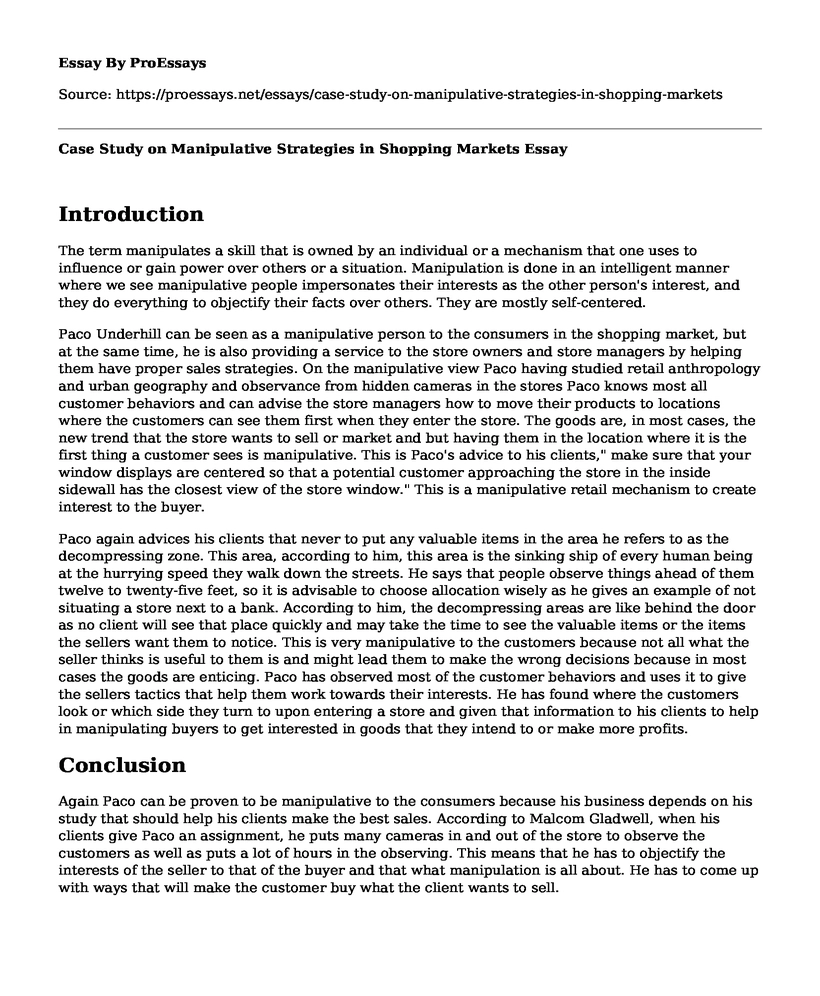Introduction
The term manipulates a skill that is owned by an individual or a mechanism that one uses to influence or gain power over others or a situation. Manipulation is done in an intelligent manner where we see manipulative people impersonates their interests as the other person's interest, and they do everything to objectify their facts over others. They are mostly self-centered.
Paco Underhill can be seen as a manipulative person to the consumers in the shopping market, but at the same time, he is also providing a service to the store owners and store managers by helping them have proper sales strategies. On the manipulative view Paco having studied retail anthropology and urban geography and observance from hidden cameras in the stores Paco knows most all customer behaviors and can advise the store managers how to move their products to locations where the customers can see them first when they enter the store. The goods are, in most cases, the new trend that the store wants to sell or market and but having them in the location where it is the first thing a customer sees is manipulative. This is Paco's advice to his clients," make sure that your window displays are centered so that a potential customer approaching the store in the inside sidewall has the closest view of the store window." This is a manipulative retail mechanism to create interest to the buyer.
Paco again advices his clients that never to put any valuable items in the area he refers to as the decompressing zone. This area, according to him, this area is the sinking ship of every human being at the hurrying speed they walk down the streets. He says that people observe things ahead of them twelve to twenty-five feet, so it is advisable to choose allocation wisely as he gives an example of not situating a store next to a bank. According to him, the decompressing areas are like behind the door as no client will see that place quickly and may take the time to see the valuable items or the items the sellers want them to notice. This is very manipulative to the customers because not all what the seller thinks is useful to them is and might lead them to make the wrong decisions because in most cases the goods are enticing. Paco has observed most of the customer behaviors and uses it to give the sellers tactics that help them work towards their interests. He has found where the customers look or which side they turn to upon entering a store and given that information to his clients to help in manipulating buyers to get interested in goods that they intend to or make more profits.
Conclusion
Again Paco can be proven to be manipulative to the consumers because his business depends on his study that should help his clients make the best sales. According to Malcom Gladwell, when his clients give Paco an assignment, he puts many cameras in and out of the store to observe the customers as well as puts a lot of hours in the observing. This means that he has to objectify the interests of the seller to that of the buyer and that what manipulation is all about. He has to come up with ways that will make the customer buy what the client wants to sell.
Cite this page
Case Study on Manipulative Strategies in Shopping Markets. (2023, Feb 12). Retrieved from https://proessays.net/essays/case-study-on-manipulative-strategies-in-shopping-markets
If you are the original author of this essay and no longer wish to have it published on the ProEssays website, please click below to request its removal:
- Operations Management Job Essay
- Assignment Example on Process Management: Lean and Six Sigma in Supply Chain Management
- Facilities of Supply Chain Essay Example
- Managerial Issues of RLK Paper Example
- Direct TV Advert Paper Example
- Essay Sample on Motivation in Organizations in Saudi Arabia
- Research Paper on Creating a Winning Brand Strategy: Unlocking the Power of Your Brand







